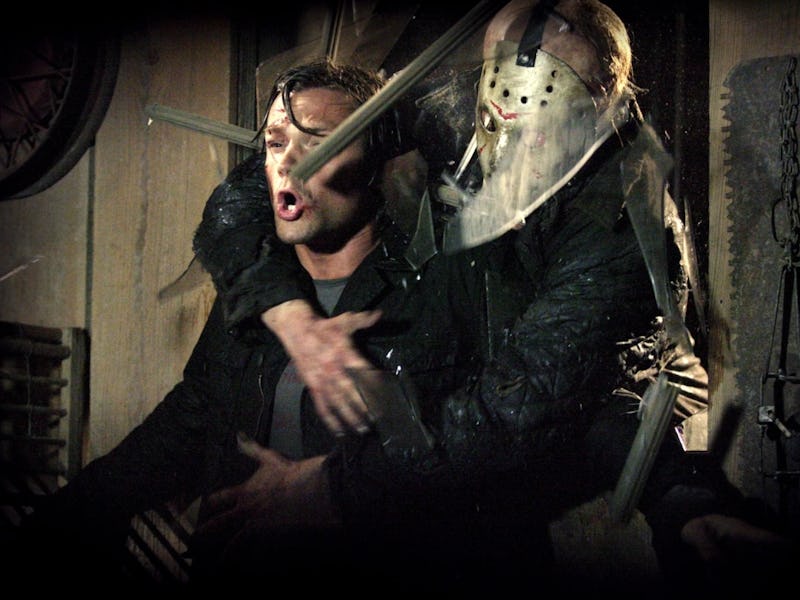One of the Smartest Remakes of the 2000s Came From a Very Silly Franchise
Once you’ve gone to space, it’s time to go back to basics.

Platinum Dunes is busy pumping out Quiet Place sequels, but in 2009, the production company was heavily invested in the horror remake business. Three of its first five releases were horror remakes, starting with its debut, 2003’s trendsetting redo The Texas Chainsaw Massacre. Rival studios scrambled to replicate box office successes like 2005’s The Amityville Horror, which grossed $107.5 million on a reported $19 million budget. With evergreen horror icons like Leatherface, Michael Myers, and Ringu’s Sadako all getting remakes and a new wave of popularity, it was only a matter of time before Jason Voorhees got his turn.
That prediction became a reality in February 2009. Platinum Dunes obtained precious and notably messy rights from Paramount Pictures, New Line Cinema, and Crystal Lake Entertainment to extend their streak of remake bangers with a new-age Friday The 13th, just in time for Valentine’s Day. Not only is it an above-average modern slasher, but it took one of the best approaches to remaking out of the Great 2000s Horror Remake Boom.
Director Marcus Nispel notched his second Platinum Dunes credit after 2003’s The Texas Chainsaw Massacre. His vision for Friday the 13th is ferocious and formidable compared to Jason’s legacy, coming out the gate like a Kentucky Derby thoroughbred. The era’s horror remakes are defined by the description “dark and gritty,” now considered Platinum Dunes’ calling card, and Nispel might be the best to commodify that vibe into an influential shooting style. Friday the 13th ditches Jason’s lumbering pace and kicks the Voorhees legacy into gear for a new generation, in a story that becomes so much more than just another predictable trip to Crystal Lake.
Writers Damian Shannon and Mark Swift develop a thoughtful update that fast-forwards through the first three Friday films to reintroduce the Jason Voorhees we all know and fear. In Friday the 13th (1980), Pamela Voorhees is the murderer. In Friday the 13th Part 2, it’s “Baghead” Jason figuring out his schtick. In Part III, Shelly Finkelstein finally gave Jason his iconic goalie mask and unknowingly debuted one of horror’s most recognizable looks. Shannon and Swift smartly condense multiple scripts’ worth of backstory into an origin that immediately establishes the Jason who dominates pop culture. It’s mean, ferocious, and understands how remakes can reimagine — and even improve upon — existing material by elevating the core competencies of renowned franchises for new audiences.
Remakes should be more than copying and pasting old ideas anew; they’re a chance to rewrite and reinvent through fresh storytelling perspectives. Friday the 13th shakes the absurd continuity of later sequels where Jason goes to Hell or battles a telekinetic girl, and works to explain a more humanized Jason who can’t just teleport around as the plot demands. Shannon and Swift develop an underground tunnel system for Jason that, while under-explained, helps with Jason’s ability to travel discreetly or call Crystal Lake home without drawing attention. The story acknowledges how Jason’s mythology wobbled off its axis, and works to dispel questions and produce a clean slate.
Jason gets right down to business.
However, Shannon and Swift never belittle 10 films worth of source material, an essential sign of respect when cooking up a remake. For every new scripted swing, there’s an acknowledgment of what fans love about Friday films. Pamela might croak during the opening credits, but that’s only so we can see more of Jason (Derek Mears) as an apex predator. It might be out of character to see Jason’s mommy issues drive him to kidnap Whitney Miller (Amanda Righetti), the spitting image of Pamela, and his agility may be unfamiliar, but he’s still a mass murder machine who slays horny college party-goers for sport. The remake sees Jason as a complex monster with more behind the mask than deformations and dead eyes, and while that might fail the nostalgia test, it exemplifies the kind of risks that keep remakes interesting. Jason 2.0 doesn’t erase the original model; he’s merely retooled to explore new storytelling methods.
An early 2000s cast owns the reckless debauchery ‘80s slashers were built on. Nispel isn’t afraid of the titillation that leads to nasty executions, as per traditional slasher rules. Travis Van Winkle and Ryan Hansen play caricatures of libido-crazed dudebros who became the genre norm, Aaron Yoo drinks beer out of a stinky sneaker, Willa Ford wakeboards topless... the hormonal primality is a wink at the audience.
Don’t get too attached to these bozos.
Shannon and Swift want you to detest Trent’s grossly masculine ego (Van Winkle nails “rich kid frat guy”) while having fun with his punishingly over-the-top tow truck fatality, just like all the other horror tropes they both embrace and cheekily exploit. Clay (Jared Padalecki) and Jenna (Danielle Panabaker), who are searching for the missing Whitney, feel like heroic voices of reason stuck with morons who doom themselves by their inability to listen, like they’ve been transported into the ‘80s and are trying to help the stoned and hammered to no avail.
Friday the 13th is a remake that delivers the best of both worlds. Newcomers to the franchise get a thorough indoctrination that speed runs Jason Voorhees’ mythology, while longtime fans will recognize everything that made Crystal Lake’s demon a genre ambassador, right down to snippets of Harry Manfredini’s legendary score. There’s enough done to justify new beginnings without abandoning marketable familiarity that dates back decades. Jason Voorhees has been idle since 2009, but Shannon and Swift’s screenplay is the balanced template all future remakes should study.